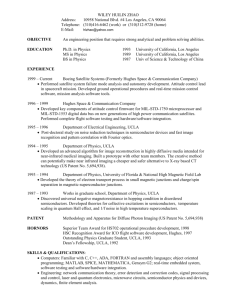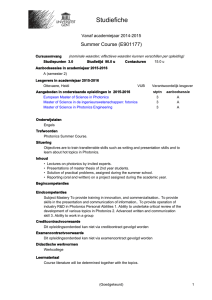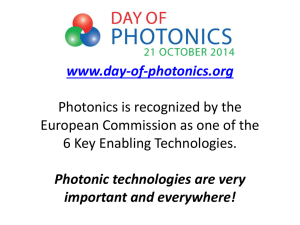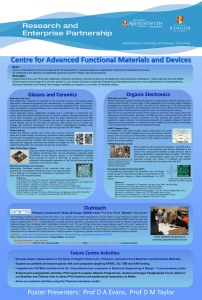Read More - Lee Lab @ Stanford
advertisement
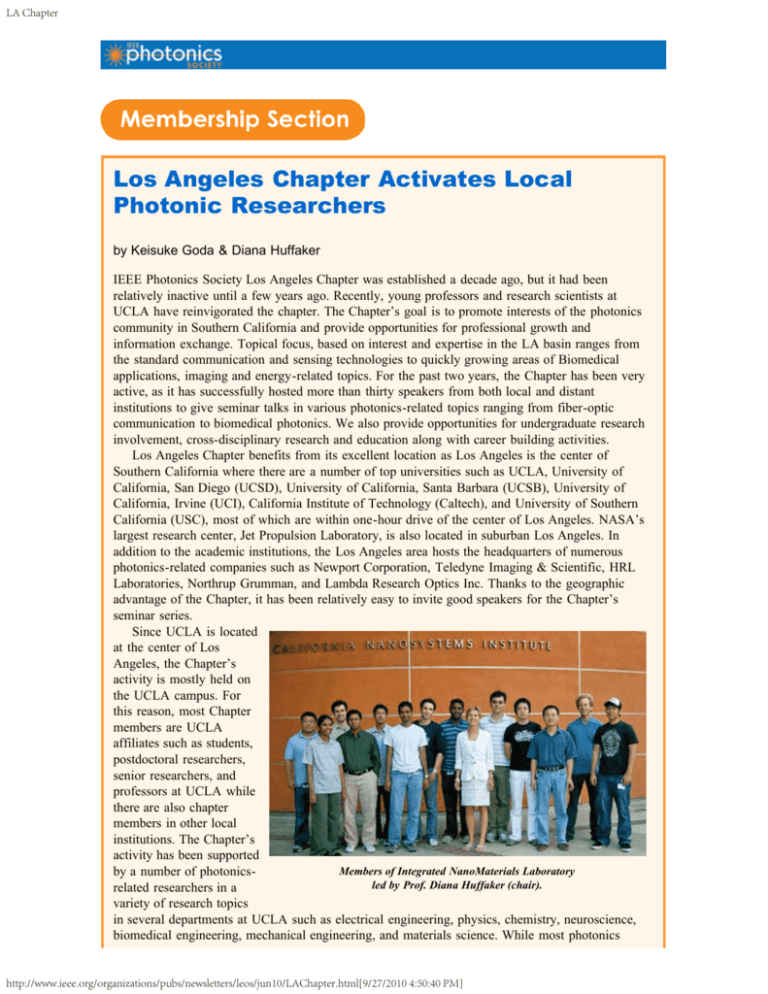
LA Chapter Los Angeles Chapter Activates Local Photonic Researchers by Keisuke Goda & Diana Huffaker IEEE Photonics Society Los Angeles Chapter was established a decade ago, but it had been relatively inactive until a few years ago. Recently, young professors and research scientists at UCLA have reinvigorated the chapter. The Chapter’s goal is to promote interests of the photonics community in Southern California and provide opportunities for professional growth and information exchange. Topical focus, based on interest and expertise in the LA basin ranges from the standard communication and sensing technologies to quickly growing areas of Biomedical applications, imaging and energy-related topics. For the past two years, the Chapter has been very active, as it has successfully hosted more than thirty speakers from both local and distant institutions to give seminar talks in various photonics-related topics ranging from fiber-optic communication to biomedical photonics. We also provide opportunities for undergraduate research involvement, cross-disciplinary research and education along with career building activities. Los Angeles Chapter benefits from its excellent location as Los Angeles is the center of Southern California where there are a number of top universities such as UCLA, University of California, San Diego (UCSD), University of California, Santa Barbara (UCSB), University of California, Irvine (UCI), California Institute of Technology (Caltech), and University of Southern California (USC), most of which are within one-hour drive of the center of Los Angeles. NASA’s largest research center, Jet Propulsion Laboratory, is also located in suburban Los Angeles. In addition to the academic institutions, the Los Angeles area hosts the headquarters of numerous photonics-related companies such as Newport Corporation, Teledyne Imaging & Scientific, HRL Laboratories, Northrup Grumman, and Lambda Research Optics Inc. Thanks to the geographic advantage of the Chapter, it has been relatively easy to invite good speakers for the Chapter’s seminar series. Since UCLA is located at the center of Los Angeles, the Chapter’s activity is mostly held on the UCLA campus. For this reason, most Chapter members are UCLA affiliates such as students, postdoctoral researchers, senior researchers, and professors at UCLA while there are also chapter members in other local institutions. The Chapter’s activity has been supported Members of Integrated NanoMaterials Laboratory by a number of photonicsled by Prof. Diana Huffaker (chair). related researchers in a variety of research topics in several departments at UCLA such as electrical engineering, physics, chemistry, neuroscience, biomedical engineering, mechanical engineering, and materials science. While most photonics http://www.ieee.org/organizations/pubs/newsletters/leos/jun10/LAChapter.html[9/27/2010 4:50:40 PM] LA Chapter research is done in the electrical engineering department, a decent number of faculty members who perform research on applications of photonics in other disciplines are spread all over the campus. Photonics Laboratory (http://www.photonics.ucla.edu) led by Prof. Bahram Jalali (former chair) of electrical engineering is one of the largest photonics research groups at UCLA. The group performs multi-disciplinary research and development in silicon photonics, microwave photonics, and biophotonics for biomedical and defense applications. More specifically, the group focuses on the development of (1) novel instruments based on ultrafast real-time measurements (e.g., imaging and spectroscopy) for cancer diagnostics and therapy and the generation and control of optical rogue waves, (2) all-dielectric photonic-assisted radio front-end technology for defense applications, (3) silicon-based photonic circuits such as silicon lasers for high-speed fiber-optic communication, and (4) ultra-wideband time-stretched digitizers for increased analog-to-digital conversion rates. Another large group is Integrated NanoMaterials Laboratory (http:// www.ee.ucla.edu/~huffaker) which is led by Prof. Diana Huffaker (chair) of electrical engineering and California NanoSystems Institute. The group performs research on directed and self-assembled nanostructure solid-state epitaxy and optoelectronic Members of Photonics Laboratory led by Prof. Bahram Jalali (former devices including solar cells chair). and III-V/Si photonics. More specifically, the group develops (1) inexpensive GaSb sensors with low dark currents for highperformance photovoltaics, (2) novel growth techniques for device applications including lasers, detectors, solar cells, and transistors, and (3) along with patterned nano-materials. Bio-and Nano-Photonics Laboratory (http://www.innovate.ee.ucla.edu) led by Prof. Aydogan Ozcan of electrical engineering and California NanoSystems Institute focuses on photonics and its applications to nano- and bio-technology, including (1) imaging the nano-world, especially in biocompatible settings, (2) providing powerful solutions to global health related problems including measurement of the cell count of HIV patients in resource limited settings, and (3) rapid and parallel detection of hundreds of thousands of molecular level binding events targeting microarraybased proteomics and genomics. For his impressive achievements, he won IEEE Photonics Society Young Investigator Award in 2009. Terahertz Devices and Intersubband Nanostructures Laboratory (http://www. ee.ucla.edu/~bwilliam) led by Prof. Benjamin Williams is broadly focused on the study of device physics and development of novel devices at the intersection of (1) engineering of quantum electronic properties in low-dimensional semiconductors, (2) engineering of artificial electromagnetic materials Members of Bio and Nano Photonics Laboratory and structures, and (3) development led by Prof. Aydogan Ozcan. of novel technologies for the generation, detection, and control of THz and mid-infrared radiation. More specifically, the group’s interests include the development of mid-infrared and THz quantum cascade lasers and THz components based on sub-wavelength dimensions for use in beam control, sensing, and imaging. Professor Kang Wang, director WIN/FENA, and his group are involved in several areas of http://www.ieee.org/organizations/pubs/newsletters/leos/jun10/LAChapter.html[9/27/2010 4:50:40 PM] LA Chapter photonics research such as integrated highly efficient optical sources on silicon. They recently demonstrated a basic nanometer scale structure to achieve both reduced anti-phase domain and dislocation densities by minimizing the strain energy and to prevent photo-excited electron-hole pairs from diffusing into silicon substrate or defects. Optical quality GaAs/InAs structure is formed on silicon using MBE growth. They are also using nanophotonics especially plasmonics applied to organic solar cell taking advantage of the strong local field enhancement around the metallic nanoparticles such that light absorption of a surrounding semiconductor material can be greatly increased. With nanoparticles in special design, the solar cell efficiency can go beyond what can be achieved by conventional organic cells. Photonics research is not limited to the electrical engineering department. For example, Prof. Shimon Weiss’s group (http://www.openwetware.org/wiki/Weiss_Lab) in the department of chemistry and biochemistry develops and applies cutting-edge techniques from fluorescence spectroscopy, fluorescence microscopy, and biological imaging to studying proteins. Another example is Prof. Katsushi Arisaka’s group in the physics department which applies the group’s expertise in particle physics to biophotonics, especially in the field of neuroscience to observe neural activity with high-speed CMOS cameras used in particle physics experiments. In addition, Prof. Jin Hyung Lee’s group (http://www.ee.ucla.edu/~jhlgroup) in the bioengineering department and the department of psychiatry and biobehavioral sciences focuses on neural information processing and plasticity, neuroscience and neural engineering, magnetic resonance imaging (MRI), and novel image contrast strategies with the help of photonics. Finally, Prof. Carlos PorteraCailliau’s laboratory (http://www.porteralab.neurology.ucla.edu/) in the departments of neurology and neurobiology performs research on two-photon imaging of neuronal structure and blood flow dynamics using femtosecond pulse lasers. For the past two years, the Chapter has successfully hosted a number of prestigious speakers for its regular and visitor seminars. On January 22, 2009, Prof. Aydogan Ozcan discussed his group’s research on the development of lens-free on-chip imaging for highthroughput cytometry and point-ofcare diagnostics. On March 19, 2009, Prof. Carlos Portera-Cailliau presented novel techniques for two-photon calcium imaging to record activity of Members of Lee Lab led by Prof. Jin Hyung Lee. cortical neurons in unanesthetized mice. In addition to the speakers from UCLA, the Chapter also brought two professors from Caltech. On September 17, 2009, Prof. Axel Scherer of electrical engineering, applied physics, and physics at Caltech came to UCLA to discuss his group’s work on the integration of nanostructures for sensor systems. On November 12, 2009, Prof. Changhuei Yang of electrical engineering and bioengineering at Caltech gave an exciting talk about how to turn biological tissues transparent by time-reversing light. Other than the speakers from the local academic institutions, the Chapter also invited speakers from outside of the Los Angeles area. On March 5, 2009, Prof. S. J. Ben Yoo of electrical and computer engineering at University of California, Davis talked about petascale cyberinfrastructure by nanoscale systems integration. On May 21, 2009, Prof. Yuhwa Lo of electrical and computer engineering at UCSD shared his vision about integrated microfluidics, photonics, and acoustics for biomedical system-on-a-chip. Furthermore, the Chapter had the opportunities to invite speakers from outside of California. On May 8, 2009, Prof. Cun-Zheng Ning of electrical engineering at Arizona State University discussed surface plasmonic and nanowire nanolasers. On April 22, 2010, Prof. Ken Crozier of natural sciences at Harvard University gave a talk about manipulation of nanoparticles and enhancement of spectroscopy with surface plasmons. As one of the IEEE Photonics Society distinguished speakers, Prof. John Dudley of University of Franche-Comte, France came all the way to UCLA to present his interesting work on nonlinear fiber optics on October 15, 2009. Finally, other than speakers at academic institutions, the Chapter also brought several industry speakers. On March 18, 2010, Dr. James Beletic, the director of Astronomy & Civil Space at Teledyne Imaging Sensors, discussed the company’s development of high-performance imaging sensors for astronomy. Most recently, on April 28, 2010, Toyohiko http://www.ieee.org/organizations/pubs/newsletters/leos/jun10/LAChapter.html[9/27/2010 4:50:40 PM] LA Chapter Yamauchi, research scientist at Hamamatsu Photonics, presented his latest work on nanometer-scale cell surface topography for label-free cell classification by low-coherence full-field quantitative phase microscopy. In summary, the Chapter’s increased activity in the recent years is supported by active photonics researchers at UCLA, resulting in strong interactions between students and researchers in different areas of research. The types of photonics research at UCLA cover a wide range of fields including biophotonics, nanophotonics, silicon photonics, photovoltaics, and microwave photonics. With the help of the geographical advantage and the large number of researchers interested in photonics or photonics-related applications, the Chapter’s activity is expected to grow in the coming years. If you would like to contact the IEEE Webmaster ? Copyright 2010, IEEE. Terms & Conditions. Privacy & Security return to contents http://www.ieee.org/organizations/pubs/newsletters/leos/jun10/LAChapter.html[9/27/2010 4:50:40 PM]
